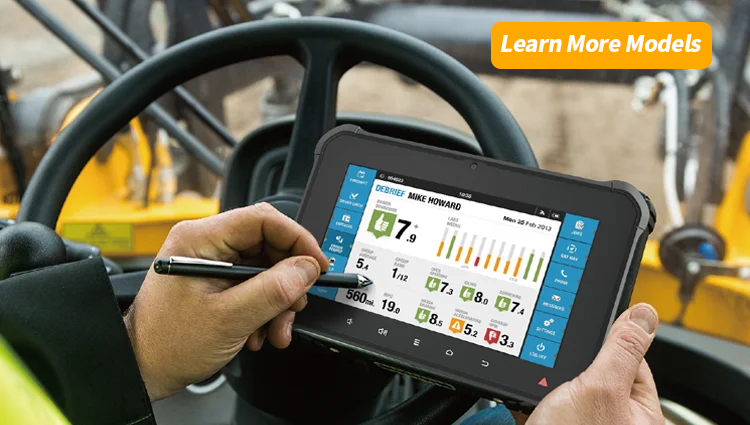IP65 vs IP67 vs IP68 Tablets: Understanding the Differences and Choosing the Right One
In today’s demanding industrial environments, rugged tablets have become essential tools for field workers, logistics professionals, and technicians. Their durability, functionality, and ability to withstand harsh conditions set them apart from standard devices. However, when it comes to selecting the right rugged tablet, understanding IP ratings such as IP65, IP67, and IP68 is crucial. These ratings define the level of protection a device offers against dust and water, ensuring reliability in the most challenging environments. In this article, we will break down the key differences between IP65, IP67, and IP68 tablets, helping you choose the best option for your needs.
What is an IP Rating?
Ingress Protection (IP) ratings are international standards defined by the International Electrotechnical Commission (IEC). These ratings indicate the degree of protection a device provides against the intrusion of solid particles (like dust) and liquids (like water). The IP rating consists of two numbers:
- First digit: Refers to the protection against solid objects and dust.
- Second digit: Refers to the protection against liquids, such as water.
For example, in IP65, the number “6” indicates dust-tight protection, while the number “5” indicates water resistance against low-pressure jets.
Let’s now explore the differences between IP65, IP67, and IP68 tablets.
IP65 Tablets: Dust-Tight and Resistant to Water Jets
IP65 tablets are designed to withstand dust and water jets, making them ideal for environments where moderate exposure to water is common. Here are the key features of IP65-rated tablets:
- Dust Protection: Completely dust-tight, preventing the ingress of any solid particles.
- Water Protection: Resistant to water jets projected at low pressure from all directions.
- Applications: IP65 tablets are well-suited for industries such as logistics, construction, and warehouses, where devices may face dust and occasional splashes of water.
Pros of IP65 Tablets
- Lightweight and versatile for fieldwork.
- Sufficient protection for moderately harsh environments.
- Cost-effective compared to higher-rated tablets.
Limitations of IP65 Tablets
- Not suitable for full submersion in water.
- May not perform optimally in extreme wet conditions.
IP67 Tablets: Dust-Tight and Submersible in Water
For environments requiring more robust protection, IP67 tablets offer enhanced durability. These devices provide dust-tight protection and can withstand temporary immersion in water up to a specific depth and duration.
Key Features of IP67 Tablets
- Dust Protection: Complete protection against dust ingress.
- Water Protection: Can survive immersion in water up to 1 meter for 30 minutes.
- Applications: IP67 tablets are suitable for outdoor work, including tasks in construction sites, mining, agriculture, and maintenance fields, where devices may encounter rain, mud, or shallow water.
Pros of IP67 Tablets
- Better water protection compared to IP65 tablets.
- Versatile and rugged for outdoor use.
- Withstands heavy dust and temporary immersion.
Limitations of IP67 Tablets
- Limited water resistance compared to IP68 devices.
- Heavier and potentially costlier than IP65 tablets.
IP68 Tablets: Dust-Tight and Resistant to Continuous Submersion
When maximum durability is a priority, IP68 tablets are the ultimate choice. These devices are engineered to withstand continuous submersion in water and provide complete dust protection, making them ideal for extreme working conditions.
Key Features of IP68 Tablets
- Dust Protection: 100% dust-tight, offering the highest level of solid particle resistance.
- Water Protection: Can endure continuous immersion in water beyond 1 meter, as specified by the manufacturer.
- Applications: IP68 tablets are perfect for industries such as marine, oil and gas, underground mining, and utilities, where devices face constant exposure to water, mud, or dust.
Pros of IP68 Tablets
- Superior water resistance for continuous immersion.
- Best-in-class protection for extreme conditions.
- Durable and reliable for rugged applications.
Limitations of IP68 Tablets
- Heavier and bulkier than lower IP-rated devices.
- Higher cost compared to IP65 and IP67 tablets.
Comparing IP65 vs IP67 vs IP68 Tablets
To help you better understand the differences between these ratings, here is a quick comparison table:
| IP Rating | Dust Protection | Water Protection | Applications |
|---|---|---|---|
| IP65 | Dust-tight | Water-resistant against low-pressure jets | Warehouses, logistics, construction |
| IP67 | Dust-tight | Temporary immersion up to 1 meter (30 min) | Outdoor work, agriculture, mining |
| IP68 | Dust-tight | Continuous immersion beyond 1 meter | Marine, oil & gas, underground environments |
Which IP-Rated Tablet is Right for You?
Choosing between IP65, IP67, and IP68 tablets depends on your specific needs and the conditions in which the devices will operate:
- Choose IP65 Tablets if your work involves moderate dust and occasional water splashes.
- Choose IP67 Tablets if you need protection against heavy dust and temporary water immersion.
- Choose IP68 Tablets for the most demanding environments with continuous exposure to water and dust.
For industries like marine operations, oil exploration, and heavy-duty outdoor work, investing in IP68-rated tablets ensures maximum reliability and performance. Conversely, for standard fieldwork or warehousing tasks, IP65 tablets may offer sufficient protection at a lower cost.
Conclusion
Understanding the difference between IP65, IP67, and IP68 tablets is essential when choosing a rugged device for your industry. Each IP rating offers distinct levels of protection against dust and water, ensuring durability and reliability in challenging environments. By assessing your specific operational needs, you can select the most suitable tablet that provides the required level of protection and performance.








